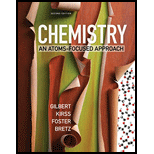
Chemistry: An Atoms-Focused Approach (Second Edition)
2nd Edition
ISBN: 9780393614053
Author: Thomas R. Gilbert, Rein V. Kirss, Stacey Lowery Bretz, Natalie Foster
Publisher: W. W. Norton & Company
expand_more
expand_more
format_list_bulleted
Question
Chapter 7, Problem 7.109QA
Interpretation Introduction
To determine:
the empirical formula of the given mineral from the percent compositions of elements
Expert Solution & Answer
Trending nowThis is a popular solution!

Students have asked these similar questions
Why does the anhydride react with the OH on the benzene rather than the OH on the carboxy group?
Answer the followings:
1- What is the IP for a amino acid? Give example.
2- What are the types of amino acids?
3- What are the structures of protein?
4- The N-Terminal analysis by the Edman method shows saralasin contains sarcosine at the N-
terminus. Partial hydrolysis of saralasin with dilute hydrochloric acid yields the following
fragments:
Tyr-Val-His
Sar-Arg-Val
His-Pro-Ala
Val-Tyr-Val
Arg-Val-Tyr
What is the structure of saralasin?
5. MATCH a term from the list below to each definition. Place the letter of the term in the blank
to the left of the definition.
a. Ligases
b. Fibrous proteins
c. Conjugated protein
d. Hydrolases
a.
b.
C.
e. Simple protein
f.
Globular proteins
g. Lyases
h.
Transferases
Proteins that are tough and insoluble in water.
Enzymes that catalyze the breaking away of a small molecule such as from a
substrate.
Enzymes that catalyze the bonding together of two substrates.
Answer the followings (Four):
1-What is the difference(s) between FOUR:
a. Glyceride and phosphoglyceride.
b. Wax and fat.
c. Soap and fatty acid.
d. HDL and LDL cholesterol
e. Phospho lipids and sphingosine.
2-What are the types of lipids?
3-What are the main lipid components of membrane structures?
4-How could lipids play important rules as signaling molecules and building units?
5. The Structure variety of Lipids makes them to play significant rules in our body.
Conclude briefly on this statement.
Chapter 7 Solutions
Chemistry: An Atoms-Focused Approach (Second Edition)
Ch. 7 - Prob. 7.1VPCh. 7 - Prob. 7.2VPCh. 7 - Prob. 7.3VPCh. 7 - Prob. 7.4VPCh. 7 - Prob. 7.5VPCh. 7 - Prob. 7.6VPCh. 7 - Prob. 7.7QACh. 7 - Prob. 7.8QACh. 7 - Prob. 7.9QACh. 7 - Prob. 7.10QA
Ch. 7 - Prob. 7.11QACh. 7 - Prob. 7.12QACh. 7 - Prob. 7.13QACh. 7 - Prob. 7.14QACh. 7 - Prob. 7.15QACh. 7 - Prob. 7.16QACh. 7 - Prob. 7.17QACh. 7 - Prob. 7.18QACh. 7 - Prob. 7.19QACh. 7 - Prob. 7.20QACh. 7 - Prob. 7.21QACh. 7 - Prob. 7.22QACh. 7 - Prob. 7.23QACh. 7 - Prob. 7.24QACh. 7 - Prob. 7.25QACh. 7 - Prob. 7.26QACh. 7 - Prob. 7.27QACh. 7 - Prob. 7.28QACh. 7 - Prob. 7.29QACh. 7 - Prob. 7.30QACh. 7 - Prob. 7.31QACh. 7 - Prob. 7.32QACh. 7 - Prob. 7.33QACh. 7 - Prob. 7.34QACh. 7 - Prob. 7.35QACh. 7 - Prob. 7.36QACh. 7 - Prob. 7.37QACh. 7 - Prob. 7.38QACh. 7 - Prob. 7.39QACh. 7 - Prob. 7.40QACh. 7 - Prob. 7.41QACh. 7 - Prob. 7.42QACh. 7 - Prob. 7.43QACh. 7 - Prob. 7.44QACh. 7 - Prob. 7.45QACh. 7 - Prob. 7.46QACh. 7 - Prob. 7.47QACh. 7 - Prob. 7.48QACh. 7 - Prob. 7.49QACh. 7 - Prob. 7.50QACh. 7 - Prob. 7.51QACh. 7 - Prob. 7.52QACh. 7 - Prob. 7.53QACh. 7 - Prob. 7.54QACh. 7 - Prob. 7.55QACh. 7 - Prob. 7.56QACh. 7 - Prob. 7.57QACh. 7 - Prob. 7.58QACh. 7 - Prob. 7.59QACh. 7 - Prob. 7.60QACh. 7 - Prob. 7.61QACh. 7 - Prob. 7.62QACh. 7 - Prob. 7.63QACh. 7 - Prob. 7.64QACh. 7 - Prob. 7.65QACh. 7 - Prob. 7.66QACh. 7 - Prob. 7.67QACh. 7 - Prob. 7.68QACh. 7 - Prob. 7.69QACh. 7 - Prob. 7.70QACh. 7 - Prob. 7.71QACh. 7 - Prob. 7.72QACh. 7 - Prob. 7.73QACh. 7 - Prob. 7.74QACh. 7 - Prob. 7.75QACh. 7 - Prob. 7.76QACh. 7 - Prob. 7.77QACh. 7 - Prob. 7.78QACh. 7 - Prob. 7.79QACh. 7 - Prob. 7.80QACh. 7 - Prob. 7.81QACh. 7 - Prob. 7.82QACh. 7 - Prob. 7.83QACh. 7 - Prob. 7.84QACh. 7 - Prob. 7.85QACh. 7 - Prob. 7.86QACh. 7 - Prob. 7.87QACh. 7 - Prob. 7.88QACh. 7 - Prob. 7.89QACh. 7 - Prob. 7.90QACh. 7 - Prob. 7.91QACh. 7 - Prob. 7.92QACh. 7 - Prob. 7.93QACh. 7 - Prob. 7.94QACh. 7 - Prob. 7.95QACh. 7 - Prob. 7.96QACh. 7 - Prob. 7.97QACh. 7 - Prob. 7.98QACh. 7 - Prob. 7.99QACh. 7 - Prob. 7.100QACh. 7 - Prob. 7.101QACh. 7 - Prob. 7.102QACh. 7 - Prob. 7.103QACh. 7 - Prob. 7.104QACh. 7 - Prob. 7.105QACh. 7 - Prob. 7.106QACh. 7 - Prob. 7.107QACh. 7 - Prob. 7.108QACh. 7 - Prob. 7.109QACh. 7 - Prob. 7.110QA
Knowledge Booster
Similar questions
arrow_back_ios
SEE MORE QUESTIONS
arrow_forward_ios
Recommended textbooks for you
 ChemistryChemistryISBN:9781305957404Author:Steven S. Zumdahl, Susan A. Zumdahl, Donald J. DeCostePublisher:Cengage Learning
ChemistryChemistryISBN:9781305957404Author:Steven S. Zumdahl, Susan A. Zumdahl, Donald J. DeCostePublisher:Cengage Learning ChemistryChemistryISBN:9781259911156Author:Raymond Chang Dr., Jason Overby ProfessorPublisher:McGraw-Hill Education
ChemistryChemistryISBN:9781259911156Author:Raymond Chang Dr., Jason Overby ProfessorPublisher:McGraw-Hill Education Principles of Instrumental AnalysisChemistryISBN:9781305577213Author:Douglas A. Skoog, F. James Holler, Stanley R. CrouchPublisher:Cengage Learning
Principles of Instrumental AnalysisChemistryISBN:9781305577213Author:Douglas A. Skoog, F. James Holler, Stanley R. CrouchPublisher:Cengage Learning Organic ChemistryChemistryISBN:9780078021558Author:Janice Gorzynski Smith Dr.Publisher:McGraw-Hill Education
Organic ChemistryChemistryISBN:9780078021558Author:Janice Gorzynski Smith Dr.Publisher:McGraw-Hill Education Chemistry: Principles and ReactionsChemistryISBN:9781305079373Author:William L. Masterton, Cecile N. HurleyPublisher:Cengage Learning
Chemistry: Principles and ReactionsChemistryISBN:9781305079373Author:William L. Masterton, Cecile N. HurleyPublisher:Cengage Learning Elementary Principles of Chemical Processes, Bind...ChemistryISBN:9781118431221Author:Richard M. Felder, Ronald W. Rousseau, Lisa G. BullardPublisher:WILEY
Elementary Principles of Chemical Processes, Bind...ChemistryISBN:9781118431221Author:Richard M. Felder, Ronald W. Rousseau, Lisa G. BullardPublisher:WILEY

Chemistry
Chemistry
ISBN:9781305957404
Author:Steven S. Zumdahl, Susan A. Zumdahl, Donald J. DeCoste
Publisher:Cengage Learning

Chemistry
Chemistry
ISBN:9781259911156
Author:Raymond Chang Dr., Jason Overby Professor
Publisher:McGraw-Hill Education

Principles of Instrumental Analysis
Chemistry
ISBN:9781305577213
Author:Douglas A. Skoog, F. James Holler, Stanley R. Crouch
Publisher:Cengage Learning

Organic Chemistry
Chemistry
ISBN:9780078021558
Author:Janice Gorzynski Smith Dr.
Publisher:McGraw-Hill Education

Chemistry: Principles and Reactions
Chemistry
ISBN:9781305079373
Author:William L. Masterton, Cecile N. Hurley
Publisher:Cengage Learning

Elementary Principles of Chemical Processes, Bind...
Chemistry
ISBN:9781118431221
Author:Richard M. Felder, Ronald W. Rousseau, Lisa G. Bullard
Publisher:WILEY